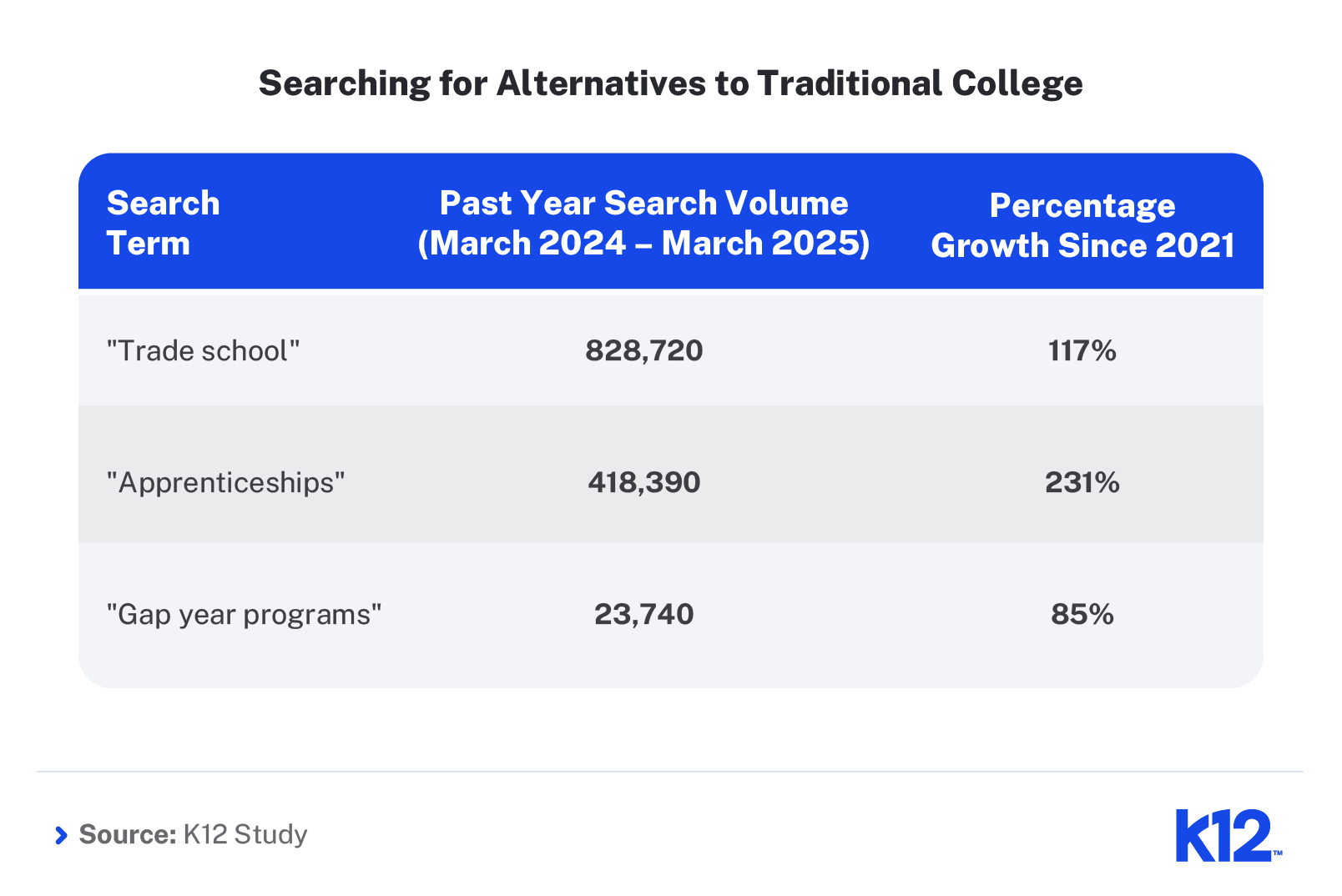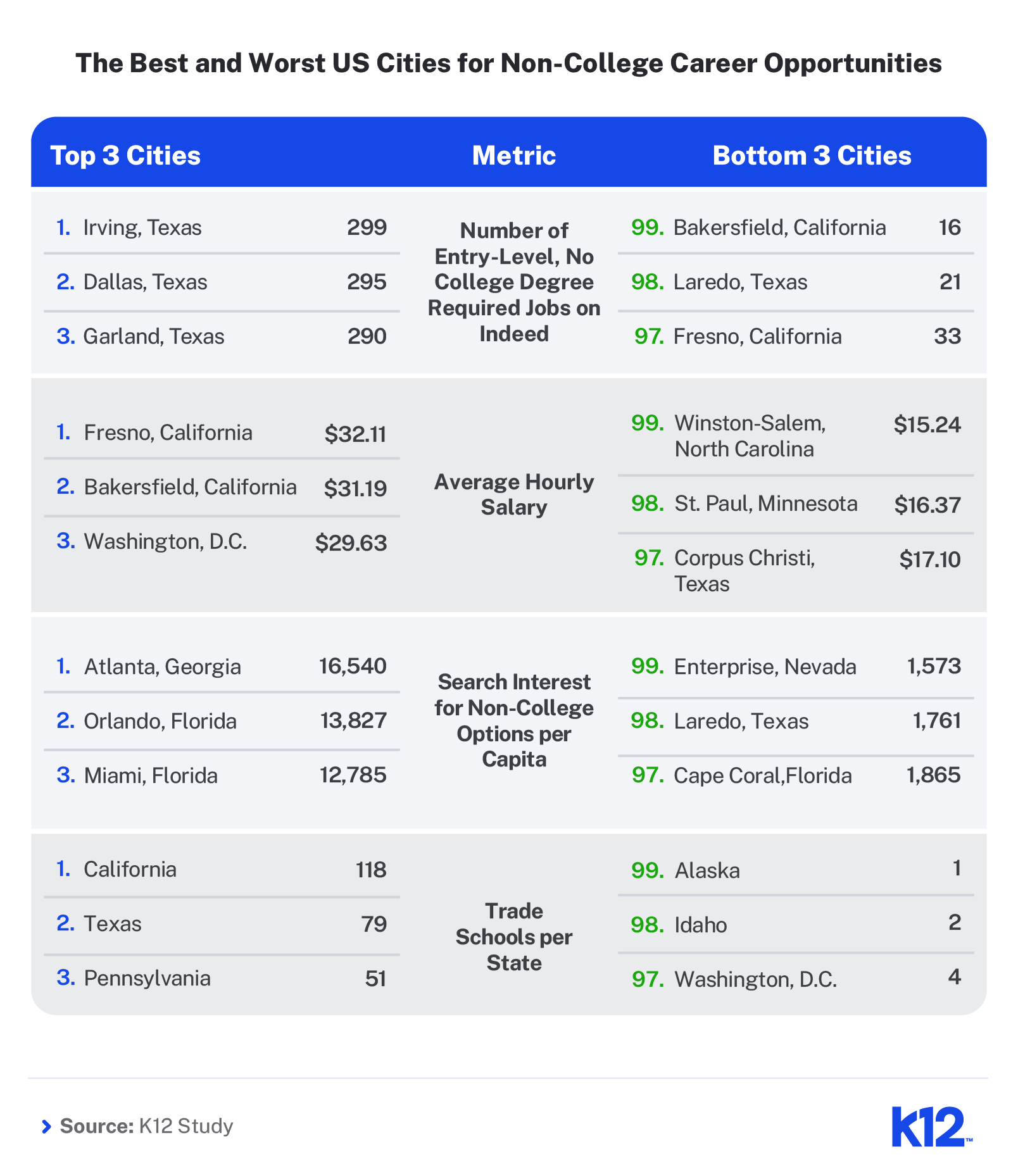As more teens explore alternatives to traditional college, families are rethinking what it means to launch a successful career after high school. With rising tuition costs and growing opportunities in trades, tech, and hands-on careers, students are searching for paths that match their goals. Our recent analysis of job markets, pay potential, and education access across 99 U.S. cities offers a helpful guide for non-college-bound graduates. It shows where high school grads can find real opportunities to grow without a standard 4-year college degree.
Key Takeaways
- Searches for non-college post-grad options surged past 1.27 million in the past year, with queries for “trade school” topping 828,000.
- Washington, D.C., tops the list for non-college-bound high school grads, thanks to high entry-level wages and job availability.
- Texas dominates the top 5, with Dallas, Irving, and Garland offering strong job markets and access to trade schools.
- Fresno, California, offered the highest average hourly wage for non-college roles at $32.11, followed by Bakersfield ($31.19).
- Irving, Dallas, and Garland, Texas, rank as the top 3 cities with the highest number of entry-level, no-degree jobs on Indeed, each posting nearly 300.
More Students Explore Alternatives to College
Students and families are increasingly turning to search engines for information about post-high school paths that don’t involve a typical college experience. We compared search volumes from the past year (March 2024–March 2025) to those in 2021 (the earliest year of available Google data) to see how interest has grown over time.

Searches for “trade school” reached over 828,000 in the past year, an increase of 117% since 2021. This significant growth highlights a rising interest in vocational education as a practical and rewarding alternative after graduation. Interest in “apprenticeships” also climbed sharply, with more than 418,000 searches, up 231% over the same period. These programs offer paid, hands-on experience and continue to appeal to students seeking career-ready skills without a four-year degree.
While the total number of searches for “gap year programs” was smaller, the increase is still notable. With nearly 24,000 searches this past year (a rise of 85% since 2021), more students are exploring the option to pause before making long-term decisions. A gap year provides time to travel, volunteer, or work, giving young people space to reflect and plan their next steps with intention.
Altogether, these non-college-focused search terms drew more than 1.27 million queries, signaling a strong interest in alternative post-high school paths.
Where Opportunity Meets Affordability
Opportunities for high school graduates entering the workforce vary widely by city. This ranking considers four important factors that influence post-grad success: availability of entry-level jobs, average hourly pay, public interest in non-college paths, and the number of nearby trade schools.
Washington, D.C., claimed the top spot thanks to a strong mix of jobs for those without a college degree and competitive hourly wages. The nation’s capital provides a solid starting point for high school grads eager to begin working right away. Atlanta, Georgia, followed closely at No. 2, leading the nation in search interest for apprenticeships and other alternative career paths.
Texas cities also ranked well, with Dallas, Irving, and Garland all landing in the top five cities. Each offers a strong blend of employment opportunities and access to trade schools. In Florida, Orlando stood out for its large entry-level job market, particularly in tourism and service roles that often welcome young workers. Out west, Anaheim and Los Angeles, California, secured top 10 spots due to their dense trade school infrastructure and a healthy number of job listings.
Breaking Down the Top and Bottom Cities
Each ranking category reveals a different strength. While some cities excel in job opportunities, others stand out in training resources or local attitudes toward non-college paths. Here’s a closer look at the top and bottom performers across key factors in our study.

Texas cities led the way in job availability. Irving, Dallas, and Garland ranked first, second, and third, respectively, for entry-level job postings that don’t require a college degree. Each city had nearly 300 of these types of jobs posted on Indeed. Texas also ranked second in the nation for the number of trade schools, with 79 statewide.
Only California had more trade schools within its borders, 118 to be exact. This state also excelled in pay potential. Fresno topped the pay rankings with an average hourly wage of $32.11, followed by Bakersfield at $31.19. However, both cities had fewer job listings than most of the other cities, which could mean stiffer competition for available roles.
In the Southeast, Florida and Georgia showed strong interest in alternative post-high school paths. Atlanta ranked first with over 16,500 searches per 100,000 residents for non-college options. Orlando and Miami followed with 13,827 and 12,785 searches per capita. High local search interest suggests a community mindset that values diverse career paths. These cities may be more welcoming and supportive of students exploring options outside of a traditional college experience.
Conclusion: Redefining the Road After High School
More students and families are starting to see that college isn’t the only path to a successful future. From trade schools to apprenticeships entering the workforce right after graduation, there are many ways to grow, learn, and build a meaningful career. Cities like Washington, D.C., Atlanta, and Dallas offer strong job markets, good pay, and a culture that supports different paths forward. For today’s high school grads, finding the right city can make all the difference in starting out with confidence and opportunity.
Methodology
To identify the best major U.S. cities for high school graduates who aren’t pursuing college, we developed a composite ranking based on job accessibility, wage potential, cultural interest in alternative paths, and educational infrastructure. The ranking includes 99 major cities and scores them across four weighted factors:
- Job accessibility: The number of entry-level job listings on Indeed requiring only a high school diploma and no experience (35%)
- Wage potential: The average hourly wage of those jobs (35%)
- Salaries reported in various time formats were converted to hourly using standard conversions: yearly divided by 2,080 hours, monthly by 173.33, weekly by 40, and daily by 8. In cases where fewer than 10 salary data points were available for a city, the overall average was substituted to reduce distortion.
- Interest in alternative paths: Per capita search interest for terms like “apprenticeships,” “gap year programs,” and “trade school” sourced from Google Trends (20%)
- Educational infrastructure: The number of trade schools per state (10%)
Rankings reflect relative performance only among the cities included in the analysis.
Limitations: This analysis is based on publicly available data from job listings and search trends, which are subject to change and may not capture every local opportunity. Salary and job availability metrics are derived from Indeed listings, which may not represent the entire labor market. Search interest data reflects curiosity but not necessarily behavior, and trade school figures were determined at the state level due to data availability. Smaller cities and rural areas were excluded to ensure consistency and reliable data across all metrics.







